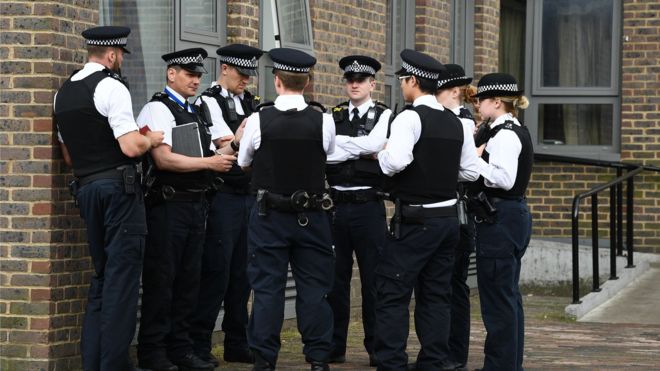 Getty Images
Getty Images
Whether crime is rising or falling is hugely important. It can affect how much is spent on policing and other related services, even how people vote. But working out what is happening is not an exact science. Reality Check explores the figures and what they mean.
When we talk about crime rates we usually look at two things: police records and the number of incidents reported in the annual 38,000-person Crime Survey for England and Wales.
Neither is wrong but the more difficult question is which best represents how much crime is actually being committed.
We are talking about England and Wales only, because Scotland and Northern Ireland have separate criminal justice systems.
Scotland has a similar survey on perceptions of crime that runs every two years, however, and in the most recent one, crimes committed against adults were down 34% since 2008-09 and 16% since the previous survey in 2012-13.
Crimes recorded by the police in Scotland are at their lowest level since 1974.
Discrepancies in the data
The England and Wales survey, which is conducted face-to-face and asks individuals about their experiences of crime, suggests crime fell by 9% in the 12 months to June 2017 compared with the year before.
In contrast, police-recorded crime went up by 13% in the past year. Violent crime went up by 19% and violence that resulted in injury by 10%.
 Getty Images
Getty Images
Under-reported crimes
The Crime Survey is generally considered a good measure of crime experienced by individuals because it is not affected by changes to how crime is recorded.
It also includes crimes that have historically been under-reported to the police.
However, it has some limitations. It does not cover crimes against businesses or people living in communal residences like care homes, prisons or student accommodation. It is also excludes crimes where there is no victim to interview, for example murders and drug offences.
And there is a time-lag in the survey, so the figures are older than police figures. This means the survey is very good for looking at long-term trends but less good at spotting emerging ones.
Questions regarding computer-based crimes and fraud were recently added to the survey but we don't have enough comparable data yet to include them in the headline figures. Including those crimes massively inflates the overall figure as they make up almost half of all crimes those surveyed said they had experienced.
Recording practices
Police records are a good measure of what's happening to well understood and well reported crimes like burglary. But it's not so good at capturing under-reported offences. And because police-recorded crime is so sensitive to changes in recording practices, it had its designation as a national statistic removed in 2014.
For example, the number of crimes described as "violence against the person" went up when two new harassment offences were added to the category.
Focused efforts from police to tackle certain crimes can also lead to higher levels being recorded.
'Ongoing improvements'
While some of the recent rise captured by police is down to "ongoing improvements to recording practices", there does appear to have been a genuine rise in violent crimes, however, the Office for National Statistics (ONS) says.
The statistical body's crime lead, John Flatley, says: "We judge that there have been genuine increases in crime - particularly in some of the low incidence but more harmful categories."
But, he says, this should be seen in the context of an overall fall in crime over the last decade, adding that the crime survey "remains our best guide to long-term trends for crime as experienced by the population in general".

















0 comments:
Post a Comment